|
|
INAUGURAL ADDRESS TO THE UNIVERSITIES OF CALCUTTA, MADRAS AND MUMBAI (THROUGH TELE-EDUCATION DELIVERY SYSTEM AT RASHTRAPATI BHAVAN
03-10-2005 : Rashtrapati Bhavan, New Delhi
At the frontier, there are no borders
"Education is a life
long journey whose
Destination expands as you travel"
On 27 April 2005, we had sown the first seed for the three universities to come together to move the frontiers of knowledge. Now I see, the young sapling coming out of the seed in the form of first live lecture in the virtual cyberspace. I am indeed delighted to be with you on this important occasion of the combined gathering of the families of the University of Calcutta, University of Madras and University of Mumbai. My greetings to the Vice-chancellors, members of the senates and faculties, students and other distinguished participants. Today is an important day in the annals of Indian Universities. Three of our pioneering universities have decided to work together and create a new wave of synergy amongst our educational institutions, breaking historical and geographical barriers. This trend, I am sure will be a fore-runner for many such unification ventures amongst educational institutions to strengthen the thought that - at the frontier, there are no borders.
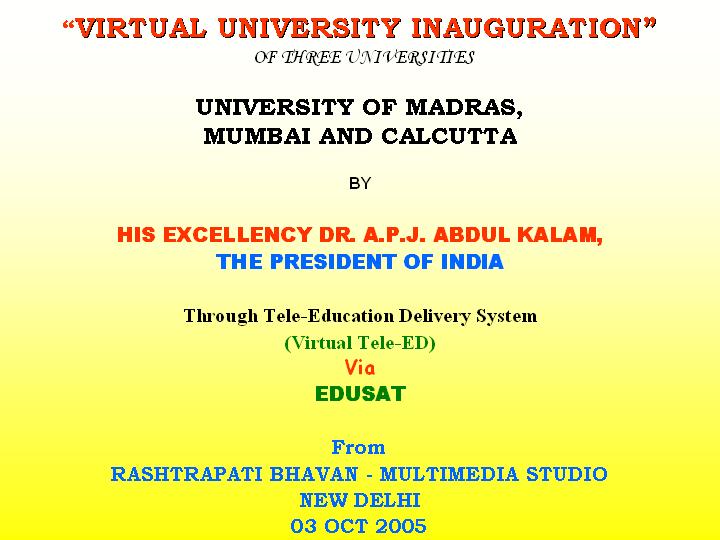
As you are aware, the Prosperous India is powered by the national economic development, the national economic development is powered by competitiveness. The competitiveness is powered by knowledge. Knowledge is powered by science, technology and innovation. Science, Technology and innovation are powered by investment rich resources. Since Universities are the reservoir of knowledge and also the prime knowledge generation centres of the nation, I would like to discuss with you about a few thoughts around the topic "At the frontier there are no borders".
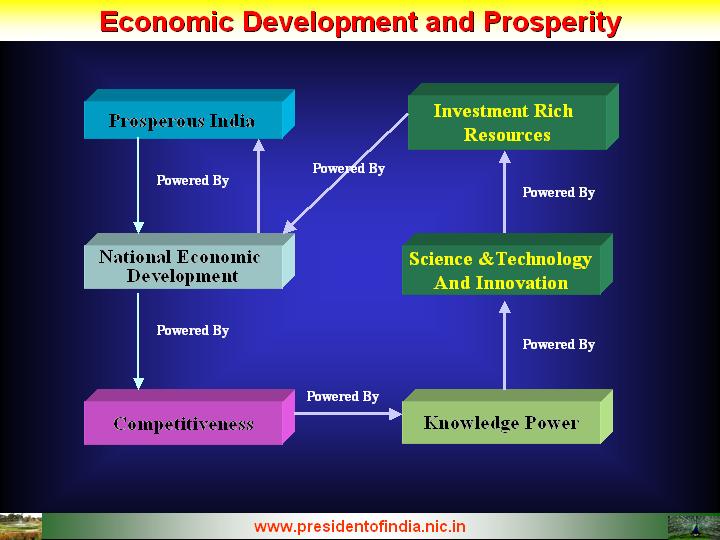

Societal transformation
The whole purpose of education in a country like India is to develop and enhance the potential of our human resource and progressively transform it into a knowledge society. The knowledge society will be a society producing products and services that are rich in both explicit and tacit knowledge, thus creating value added products. The real capital of this knowledge society will be its knowledge workers. The society will be highly networked to create knowledge intensive environment along with enabling process to efficiently create, share, use and protect knowledge. Our education system should re-align itself at the earliest to meet the needs of the present day challenges and be fully geared to participate in the societal transformation. The networking of these three universities is the first step towards creating the universities that could meet the demands of the knowledge era ? an era that was born out of convergence of technologies and it is only natural that the human minds should also converge in the knowledge era.
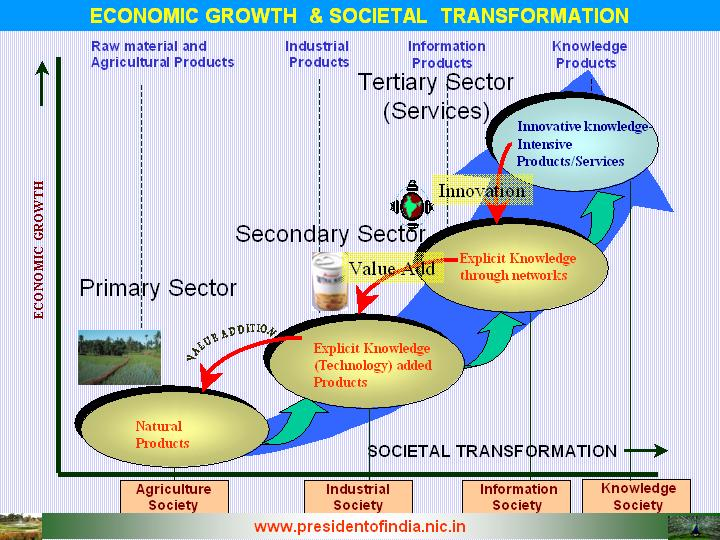

Changing Pattern of Society
When the world was moving from the industrial to information and knowledge era, we witnessed a changing pattern in the sectoral share of GDP and the number of people employed in each sector. The sectoral share of Gross Domestic Product (GDP) percentage has undergone a considerable change. Contribution of agriculture to India?s GDP has reduced from 39% to 22% during the period 1979 to 2004. During the same period contribution of manufacturing sector has moved from 24% to 27% and whereas the contribution from the services sector has increased from 37% to 51%. There has been considerable change in the employment pattern also. The percentage of people employed in agriculture has come down from 64% to 54%. Simultaneously, the percentage of people employed in manufacturing has gone up from 15% to 19% and in the service sector from 20% to 27%. This trend has to continue and by 2020 our employment pattern should aim at 44% in agriculture, 21% in manufacturing and 35% in service sectors. The displacement of 10% people from agriculture sector has to be facilitated through skill enabling for undertaking value added tasks in the rural enterprises so that migration to urban area is reduced. Instead of the person from the rural areas going to urban towns in search of jobs in manufacturing and services sectors, PURA (Providing Urban Amenities in Rural Areas) facilitates creation of employment in the rural areas itself. PURA achieves this by providing physical, electronic and knowledge connectivities to a cluster of villages thereby leading to their economic connectivity and prosperity. Knowledge creation and knowledge utilisation is the key to the success of a PURA programme. Here, the Universities have to play a major role in creation and dissemination of knowledge.
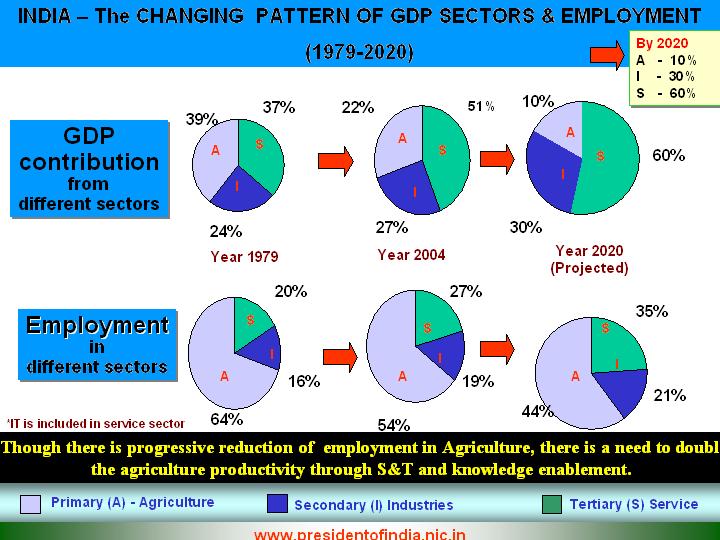

Characteristics of the Knowledge economy
I was studying different dimensions of knowledge society how will it be different from the industrial Economy. In the knowledge economy the objective of a society changes from fulfilling the basic needs of all round development to empowerment. The education system instead of going by text book teaching will be promoted by creative, interactive self learning ? formal and informal with focus on values, merit and quality. The workers instead of being skilled or semi-skilled will be knowledgeable self empowered flexibly skilled. The type of work instead of being structured and hardware driven will be less structured and software driven. Management style will be delegative rather than being directive. Impact on environment and ecology will be strikingly less compared to industrial economy. Finally, the economy will be knowledge driven and not industry driven. To meet these needs we require Knowledge Grid.
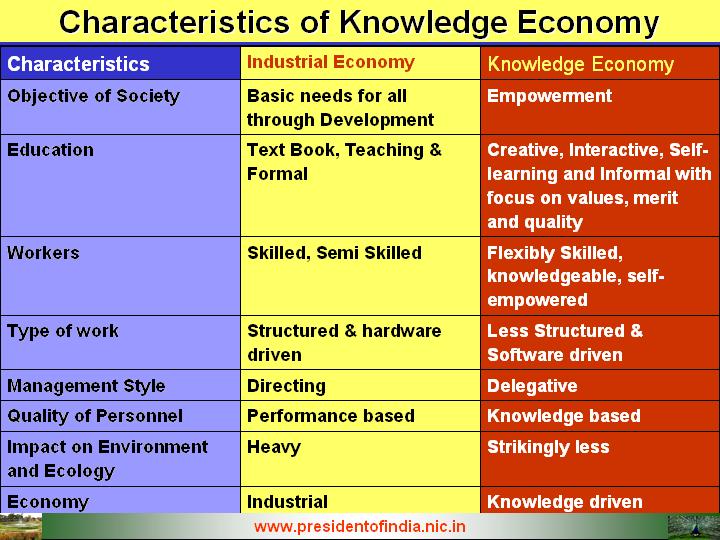

Knowledge Grid
What the three of the oldest and prestigious universities had started should soon spread like a wildfire but with passion and engulf the entire education system both vertically and horizontally, starting from kindergarten to remote research and spreading across multiple disciplines without any concern for geographical location or the time. This has been the motivation for the nation?s programmes on knowledge grid. Promoting excellence in the education system will need creation of world class educational institutions. This will involve formulation of innovative methods by which information and knowledge are accessed fast for meeting the demands of national challenges pertinent to your academic and research and development activities.
We have rich knowledge institutions but what we have to add is connectivity. This connectivity today technologically is possible but would need creation of high band width reliable network infrastructure to the extent of minimum 10 Gigabits per second all through the country to provide uniform access of knowledge in different regions.
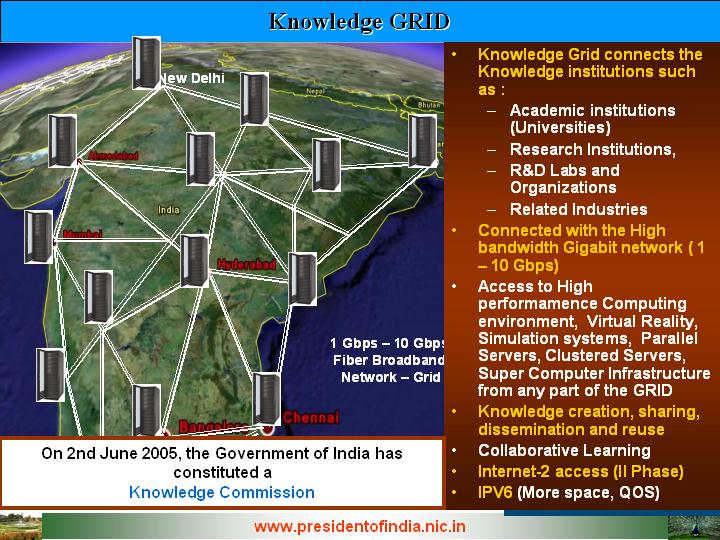

The benefits of knowledge connectivity
The connectivity must transform into a network and provide a seamless access between the knowledge creator that is the Universities and institutions, the R & D institutions that convert knowledge into products and the knowledge consumer that is the industry and people. As an example, now let us take Jatropha plantation to generation of bio-fuel. The Jatropha plantation technology and methods is provided to the farmers by the agricultural university. The R & D institutions work on converting Jatropha seeds into bio-fuel and by-products. A rural small scale industry will establish an enterprise for producing bio-fuel and marketing it. The rural development and agricultural ministry provide the policy framework for pricing and use of bio-fuel. Also, there is a need for the University to work on the development of a variety of hybrid seeds for increasing the productivity of oil from the seeds. Thus we can see there is a close cycle between the farmer, researcher, educational institutions, industry and the user requiring variety of knowledge input at different stages which can be made available effectively only if all these institutions are brought under knowledge grid and a common communication protocol with high speed access is made available to them. Connectivity is the key to success of our development programmes.
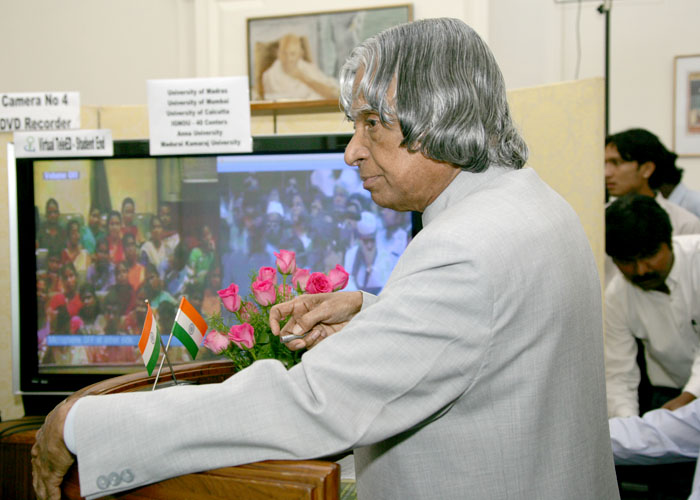

Knowledge Commission
On 2nd June 2005, the Government has constituted a Knowledge Commission to deal with matters relating to institutions of knowledge production, knowledge use and knowledge dissemination. The mandate of the Commission is to sharpen India's "knowledge edge". It will also explore ways in which knowledge can be made more widely accessible in the country for maximum public benefit. Also it will advise on how India can promote excellence in the education system to meet the knowledge challenges of the 21st Century. In effect the aspirations of India to become a developed nation capitalizing on its knowledge and its importance in the emerging new era, will solely depend on the contributions of the universities to the national missions.
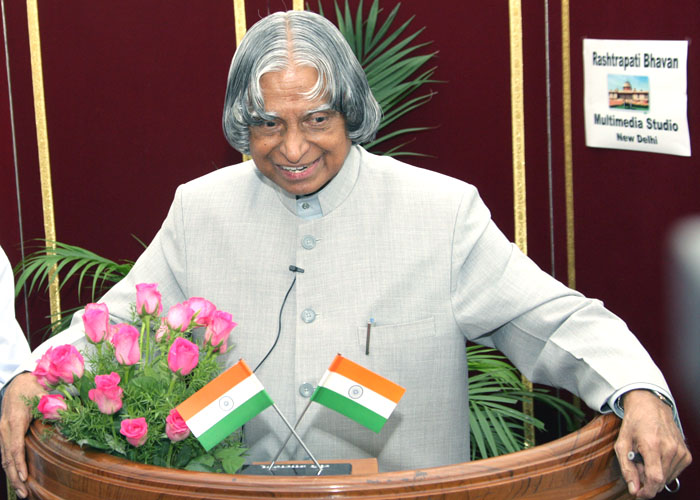

Possible R&D Areas for the Universities towards National Development
Some of the major areas where our Universities can contribute are energy (solar, bio-fuel and Thorium Nuclear Reactor), second green revolution for increasing the food grains output from the existing 200 millions tonnes per annum to 400 million tonnes with reduced availability of land, reduced availability of water and reduced farm work force and provision of potable safe drinking water to all the citizens, energy efficient green habitat for the citizens, enhancing our ICT export market through the development of knowledge products and develop nano-technology based system for societal transformation. Some of the examples are energy storage, production and conversion, enhancing agricultural productivity, water treatment, disease diagnosis and screening, drug delivery system, food preservation and storage, air pollution control and ventilation, construction, health monitoring and vector / pest destruction and control.
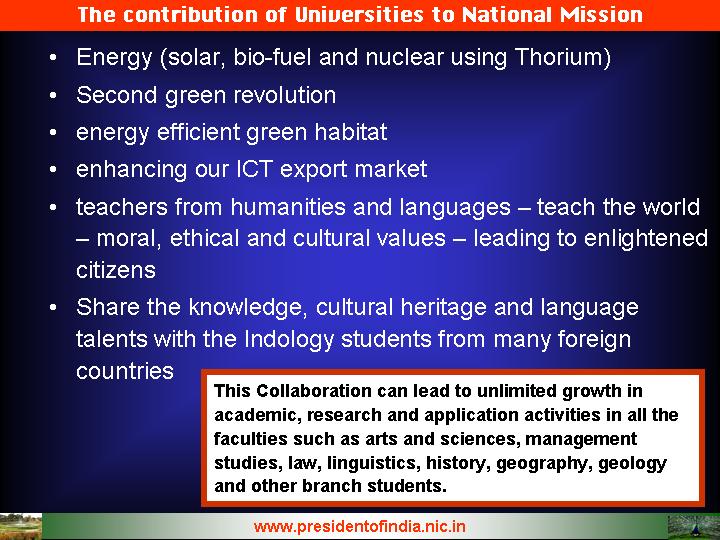
In addition to the above, the teachers from humanities and languages are also an important component of our educational system. They give the moral, ethical, cultural and commercial values. This will protect the world from degrading towards a very cruelly materialistic one. The humanities and language experts can also carry our culture and heritage exchange through a well planned tele-education delivery system to the twenty million people of Indian origin living in different parts of the world. I am sure one day; India will become the role model for creating and consuming knowledge products and still maintaining its moral, ethical and cultural value system about which many generations of human kind would be proud of. Also, they can meet the requirement of their Indology students of different countries who are keen to learn about Indian culture and Indian languages. This connectivity will enrich not only the students of the Universities but will also make them cultural ambassadors of the nation. Similarly, this collaboration can lead to unlimited growth in academic, research and application activities in all the faculties such as arts and sciences, management studies, law, linguistics, history, geography, geology and other branch students.
During my recent visit to Russia I had suggested the launch of a youth satellite exclusively for use by youth of different countries. I am sure the members of the three universities assembled here would like to participate in this youth satellite programmes. In this connection, a good example is the micro satellite built by Anna University in collaborations with ISRO. In a similar way, I suggest a common mission between these three universities can be evolved. Now I would like to discuss about virtual university.

Virtual University
The Association of three universities should lead to a creation of a virtual university through networking which you have already started. You have to only position the infrastructure and the modalities in place so that you can become the first operational virtual university in the country combining 450 years of accumulated academic and research strength of the three universities.
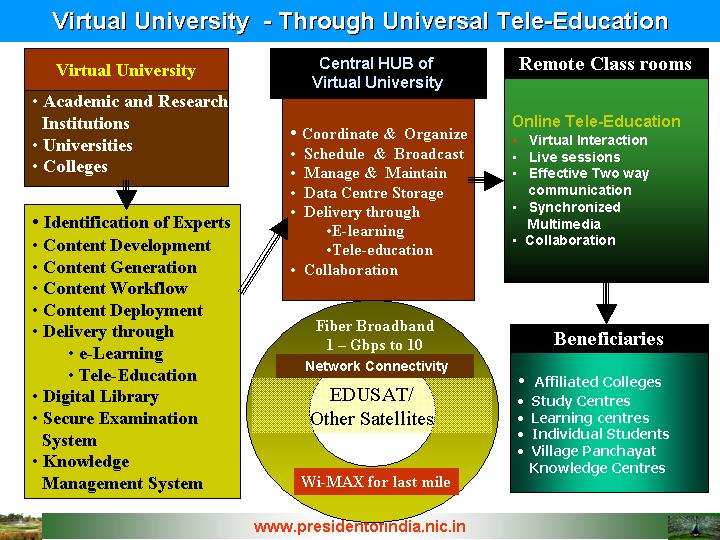
In the world which is shrinking to become a global village, it is also important to produce students who ultimately become the knowledge workers in our economy to be global citizens. In this regard, at least to start with we must be able to offer, courses of predictable standards across the three universities. A student should be able to attend courses of his choice without geographical constraints. The three universities must co-sign the new degrees from this Virtual University. The day when all our universities begin to offer this flexibility and assure constant and consistent high quality, India could proclaim to be the knowledge super power.

Attracting students to Virtual Universities
While it is unarguable that the Virtual Universities provide us with technologies of the future and the most economic way of scaling high quality education in the country, they are no substitute to the campus based education. The challenge to the Virtual Universities is to provide the best of breed of both the worlds. In this process, we could plan an optimum mix of direct contact hours between the students and the teachers and also amongst the students themselves. These interactions should also be used as a platform to excite the students to take to learning in the new paradigm.
In the world of Virtual Universities the equitable access to all its participants is the primary goal. Unlike in the real world, the equitable access is always the democratic average, in the Virtual Universities the equitable access always means the equitable access to the best resources ? be it the teachers, be it the library, be it the laboratory, available across the network. In effect, the network brings the best of its participants to every one of its participants.
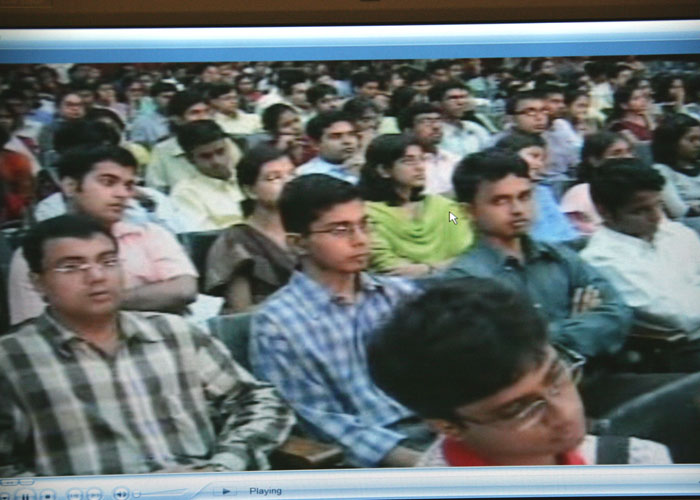

Phases of learning
The three L?s of learning are the lectures, library and laboratories. They require increasing bandwidth from a few 100?s of kilobytes for the lectures to a few megabytes for the formal digital libraries and the informal world of knowledge from the Internet, to gigabits of connectivity for remote laboratories in the world of high precision science and engineering. As the bandwidth becomes cheaper and available in abundance, universities should be able to run remote instruments and facilities as complex as NMR to Wind tunnels. This will ultimately provide equitable access to the entire education system beyond just the lectures and the lecturers. Thus the bandwidth is the demolisher of imbalances and a great leveler in the knowledge society.

A model Virtual University
At Rashtrapati Bhavan, I meet many experts from all over the world and from India, who have made the virtual universities of very high quality. At the same time, I also see in some of them a myth that many in the educational segment have started to have a wrong notion that anything connected to the web is a Virtual University. There must be a model code of evaluation and accreditation of quality Virtual Universities in the country and any impersonator must be weeded out immediately. For a nation, that has grown from maintaining quality in class room based education to distance education, this is a natural progression.
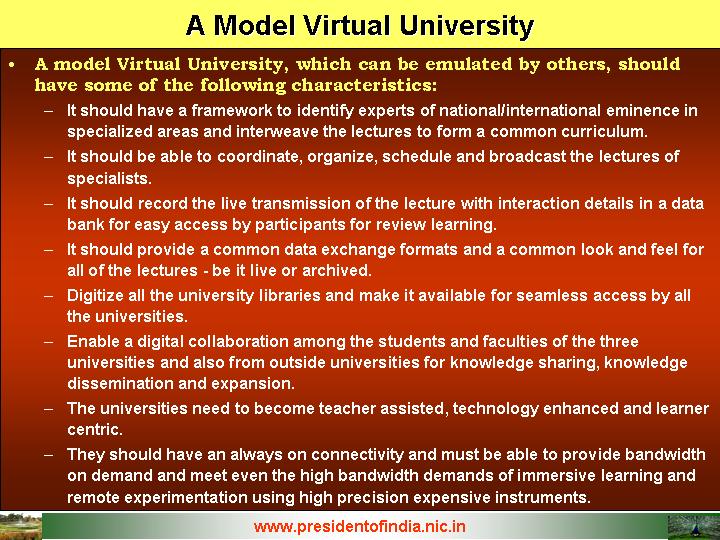
A model Virtual University, which can be emulated by others, should have some of the following characteristics:
a) It should have a framework to identify experts of national/international eminence in specialized areas and interweave the lectures to form a common curriculum.
b) It should be able to coordinate, organize, schedule and broadcast the lectures of specialists.
c) It should record the live transmission of the lecture with interaction details in a data bank for easy access by participants for review learning.
d) It should provide a common data exchange format and a common look and feel for all of the lectures - be it live or archived.
e) Digitize all the university libraries and make it available for seamless access by all the universities.
f) Enable a digital collaboration among the students and faculties of the three universities and also from outside universities for knowledge sharing, knowledge dissemination and expansion.
g) The universities need to become teacher assisted, technology enhanced and learner centric.
h) They should have ?an always on connectivity? and must be able to provide bandwidth on demand and meet even the high bandwidth demands of immersive learning and remote experimentation using high precision expensive instruments.
I wish that with the dedication and the history of achievements of the three universities ? Calcutta, Madras and Mumbai, this collaboration would lead to the creation of the high quality Virtual University that will attract the nations best of talents and produce borderless knowledge workers who will strive to make the world a much better place to live. The Virtual University should graduate into a modern Nalanda and attract students from all over the world ? a true global village producing global citizens with borderless talents, ethics and ethos.
All this would lead to synergizing the strengths of the universities in promoting quality education to our students in a cost effective manner located in these three regions leading to academic excellence and promotion of knowledge society.

Participation of universities in Rural Development
For India to be a developed nation, it is essential that there is a massive scheme for development of the rural areas, as 70% of our population lives in villages. Hence the Government has announced the introduction of a scheme called PURA i.e. Providing Urban Amenities in Rural areas. PURA model envisages habitat design to improve the quality of life in rural areas and also removes urban congestion. It is essentially conceived around four types of connectivities with the aim to speed up process of achieving total rural prosperity. Physical connectivity enables high mobility to villagers so that they can interact and use common infrastructure such as school, health centres and markets. The electronic connectivity with telephones and internet facilities bring them together and interact with anyone anywhere in the world. Knowledge connectivity will transform the rural area in education, health care, application of science for crop, water and forest and management, environment protection and cooperative product marketing. The combination of all these three connectivities provides the economic connectivity with small-scale industries, agro and food processing, warehouses, micro power plants, renewable energy farms and banks. The four connectivities will bring prosperity to the villagers and improve quality of life. Universities of Calcutta, Madras and Mumbai can adopt 20 to 30 villages located in near the metropolitan cities and create a model PURA with all the connectivities and enterprises with large scale employment generation potential.
A PURA complex each can be planned in Diamond Harbor region of West Bengal by Faquirchand College, Chengalpattu region in Tamil Nadu by Vedachalam Government Arts College and Palghar region in Thane district, Maharashtra by Sonopant Dandekar Arts, Science and Commerce College. The Universities can become facilitators by nominating the support of Departments of Management Studies, Computer Science and Information Technology, Bio-technology and Biology, Energy and other related areas of specialization for planning and executing these PURA complexes in collaboration with the Government, industries and societal transformers like NGOs. Funding can come from the Government, banks, industry, NGOs and self help groups. The graduates and post-graduates of the University should become enterprise leaders and become employment generators rather than employment seekers in these rural enterprises. Now I would like to discuss a model PURA which is in operation in Tamil Nadu.
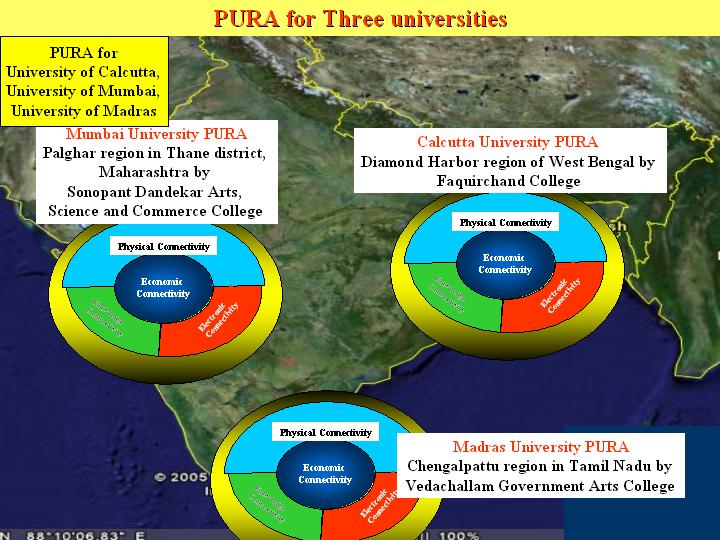

Periyar PURA
Last year I had visited Periyar Maniammai college of Technology for Women and inaugurated a PURA Complex. I thought of sharing with you the developmental concept of a cluster of over 65 villages near Vallam, Thanjavur district of Tamilnadu which involves a population of 3 lakhs. This PURA complex has all the three connectivities - physical, electronic and knowledge - leading to economic connectivity. The centre of activity emanates from the women engineering college that provides the electronic and knowledge connectivity. I understand that now five of the Periyar PURA villages have been connected with Wi-MAX connectivity. Periyar PURA has health care centres, primary to post graduate level education and vocational training centres. This has resulted in large scale employment generation and creation of number of entrepreneurs with the active support of 850 self-help groups. Two hundreds acres of waste land has been developed into cultivable land with innovative water management schemes such as contour ponds and water sheds for storing and irrigating the fields. All the villagers are busy in either cultivation, planting Jatropha, herbal and medicinal plants, power generation using bio-mass, food processing and above all running marketing centres. This model has emanated independent of any government initiative. The committed leadership has been provided by the Engineering institution. This gives me the confidence that PURA is a realizable proposition and this movement can be multiplied by thousands of entrepreneurs, educational administrators and philanthropic institutions with the support of the government agencies.
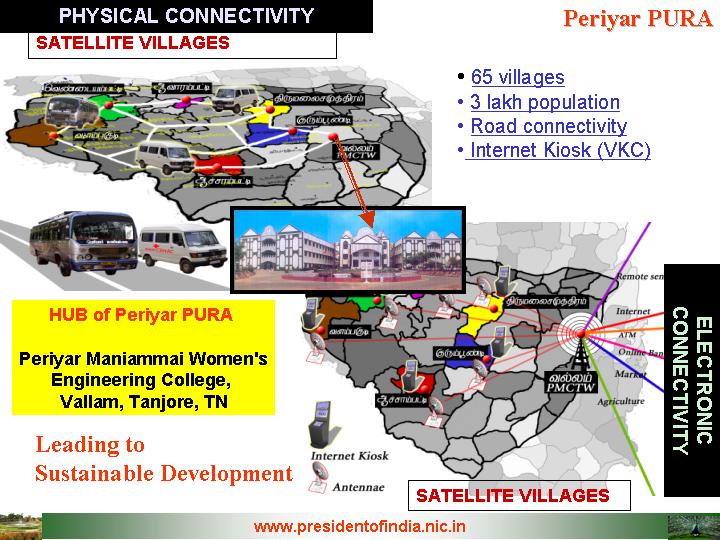

Global Human Resources Cadre
In the 21st century, India needs large number of talented youth with higher education for the task of knowledge acquisition, knowledge imparting, knowledge creation and knowledge sharing. I am working for it. At present India has five hundred and forty million youth under the age of 25 which will continuously be growing till the year 2050. Keeping this resource in mind, the Universities and educational systems should create two cadres of personnel: (1) a global cadre of skilled youth with specific knowledge of special skills (2) another global cadre of youth with higher education. These two cadres will be required not only for powering the manufacturing and services sector of India but also will be needed for fulfilling the human resource requirements of various countries. Thus, the universities will have to work towards increasing the through put of the higher education system from the existing 6% to 20% by the year 2015, 30% by the year 2020 and 50% by the year 2040. The other Indians who are not covered by the higher education system should all have world class skill sets in areas such as construction, carpentry, electrical systems, repair of mechanical systems, fashion design, para-legal, para-medical, accountancy, sales and marketing, software and hardware maintenance and service, software quality assurance personals etc. No Indian youth should be without either a world class higher education or without world class skills sets. This is the mission which must be undertaken by all our Universities and the educational systems particularly the consortium of the three universities namely Calcutta, Madras and Mumbai. I would like to appeal to the youth who are from these universities to create new models to make such a thing possible. We have to start right now to realize this goal since the overall time available for such an educational growth is short. A National Policy for creating a "Global Human Development Cadre for India", has to emerge. I am working for this mission.
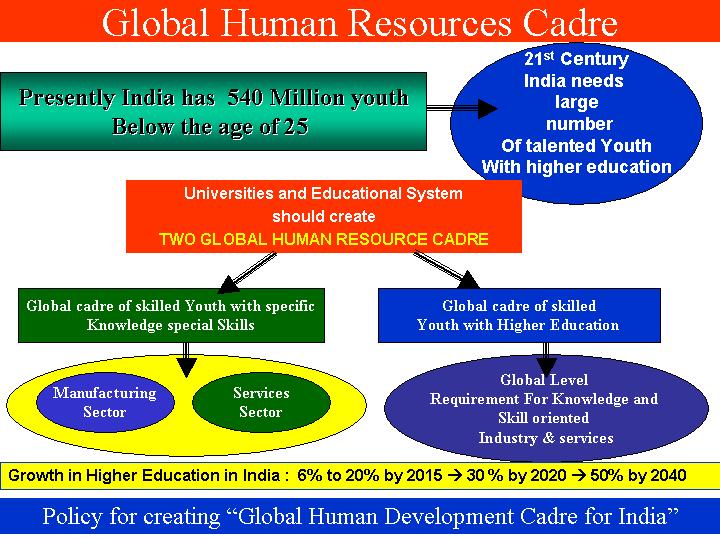

Conclusion
For realizing excellence in education, what we need is quality faculty, infrastructural facility, national and international high bandwidth connectivity, availability of knowledge sources. In addition we need a good learning environment, collaborative environment, exposure to the international best practices and constant promotion of innovation and creativity. The higher the research intensity in a University environment, better will be the teaching quality. The collaboration of the three universities should provide these features to all the constituents? colleges in different regions and become role models for the entire country in propagating, attractive and high quality virtual education. Each University, its faculty members and the students must try to say "what they can give to other two universities." The capacity building in areas of importance to the national development is a primary role of the teachers. Today science and technology are directly linked to the nation?s economic development and their sustainability is related to the applicability and relevance of education system in uplifting the 260 million people living below the poverty line and those who live in the rural and urban areas. The attitude of giving between the universities will enhance the efficiency in knowledge creation and speedy dissemination. Knowledge gets multiplied when connected and circulated. The momentum that you have given to the concept of Virtual University should soon engulf every university, school and research institutions and make the whole India connected by a Knowledge Grid. Finally I would request all faculty members of the University, each one of them to ask themselves a question "what I would like to be remembered for?" during the phase of my university mission.
I inaugurate the Virtual University formed by the consortium of three Universities, you are the societal transformers of the 21st century; you work in the cyberspace and advanced technologies and produce a visible growth in our economy in the real world. I wish you all success in your mission of promoting excellence in education and capacity building among students and finally evolving the creation of the knowledge society for the nation.
May God bless you.
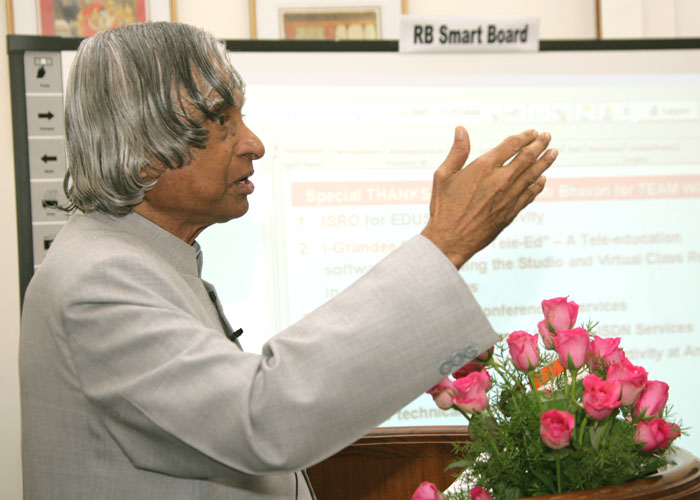

Questions from the Students of Calcutta University
1. Traditional herbal medicines are expected to break newer and newer grounds in near future. How should the R &D in India be directed today to explore & protect herbal resources, particularly for utilization in medicinal purposes?
- Mili Das, 3rd Year, B.Tech, Pharmaceutical & Chemical Technology
Ans. This is a combined task between the universities, R & D laboratories and Pharma industry and there is also a need for protecting our intellectual property rights in the traditional herbal products area. Educational institutions should assist in the creation of bio-diversity map of all the regions so that the wealth of herbal species available in the country will be known to the planners. Researchers in collaboration with the industries should constantly work towards the development of new molecules.
2. There is an excess of food grains in India, thanks to Green Revolution. But there is poverty and hunger too. What is wrong with our system that can?t take food to people who need it most?
- Bhaswati Bhattacharya, 1st Year M.Sc., Bio-informatics & Biophysics
Ans. Food security can be studied from three different view points. First, availability of food, which depends upon production and distribution; second access to food that is guided by purchasing power; and third food absorption. What we have achieved through green revolution is the availability of food. We have not so far increasing the purchasing power among the masses. This will need creation of large number of employment in various sectors of the economy. This is what now we are attempting through the creation of PURA complexes in our rural sectors.
3. A majority of the bright students at the high school level aspire to become a doctor or an engineer. How can these rich minds be motivated towards taking up research as a first grade career option?
- Arunava Roy, 1st Year Biotechnology
Ans. (a) It is essential to have an assured career in science for a certain number of high quality committed scientists with aptitude towards research. There should be a minimum annual intake of about 300 M.Sc and 100 Ph.D scientists with proper emoluments and assured career growth in the organisations such as ISRO, DRDO, Atomic Energy, CSIR, DST and the Universities. The private and government funded universities must be encouraged to appoint M.Sc and Ph.D who have been selected through a nationally coordinated competitive selection process. This will be a great motivator for the science students and also their parents for pursuing advanced courses in science. This is the first and foremost need for attracting young people to career in science ? an assurance to the youth and the parents that the future is secure, once they take science as a career.
(b) The experienced scientists and policy makers of the organisations must recognize the talents available in the organisation irrespective of the position and empower the young scientists to create state-of-the art laboratories once they have concrete thoughts and vision. Prof Vikram Sarabhai in the initial stages of ISRO brought in a culture of management which encouraged and satisfied the vision of the young scientists which collectively succeeded in making the mission of the organisation a reality.
(c) Universities and Research and Development institutions must encourage and facilitate the young scientists to write quality research papers in frontier areas and in prestigious journals. They should also facilitate the youth to present the papers in national and international seminars and symposiums which will enable them to assess their standard against international benchmarks. Encouraging youth to be lead authors while publishing the joint research would be a very good gesture that the youngsters would cherish for many years.
(d) Based on my experience during my interaction with the 600,000 students, I realize that they are looking for role models, whom they would like to follow after their 10+2 career. Approximately 7 million students appear for plus two examinations every year. Out of which 3 million students are from the science stream. To attract this youth towards a career in science, we need many novel ideas. The youth must be made to understand the beauty of doing science, the pleasure of doing science and the ultimate bliss when the results of science make you understand the nature, master it, control it and finally make things that improve the quality of life of the human kind. Every one of us, scientists must pledge that we will at least spend sometime visiting the schools to ignite the young minds by recounting our own experiences.
All these actions are required to motivate young minds towards the scientific career.

4. Mr. President Sir, for the past two decades India has observed accelerated economic growth in all aspects, and is on the way of being a world leader in computer software services. Nevertheless, Human Development Report 2005 of UNDP projects a gloomy picture of India in children malnourishment, gender discrimination and rural poverty. Your Excellency, how would you envisage "total development of our country" in this paradoxical situation?
- Pradipta Kundu, 2nd year Biotechnology
Ans. We must realize that we are in a growth path. For example, our position in Growth Competitive Index has improved from the previous 56 to 50. Similarly we are making rapid progress in many areas. However, we have a long way to go in improving the nourishment of children and improving their education particularly Women education. This will reduce the population growth and also prevent gender discrimination. Our health care system has to provide quality health care to reach the rural masses at an affordable cost. The rural poverty can be addressed by working towards provision of large scale employment through PURA and national missions such as Bio-fuel, bamboo, textiles, waste land development, conversion of fly-ash into wealth, solid municipal waste into energy, village knowledge centre, and development of paramedics. This is how we can bring about total development of the country.
5. In spite of having a huge pool of scientific talent, India has not contributed that substantially in the world of science, as it should have. However, it is an accepted fact that the same individuals perform exceedingly well once they go abroad. Why do such things happen?
- Kunal Chatterjee, 2nd year M.Sc., Microbiology
Ans. As soon as we became independent, the country was infested with problems to bring in urgently needed technologies for steel, civil structures, hydro dams and thermal power stations. Our concentration was directed towards solving burning problems like feeding the population, providing water, shelter and health care. The political visionaries at that time, in spite of our having a very weak economy, decided to wisely setup what ultimately has become the science base of our country such as Atomic Energy, Space, CSIR, DRDO, DST, DBT etc., The country also setup the powerful educational base including the creation of IITs and many universities, which had a unique blend of science and technology.
Today the country has become one of the strongest in the world in terms of scientific manpower in capability and maturity. Our economy has also become strong. Hence, we are in a position not only to understand the technologies that we may have to evolve, but also to create our own technologies with extensive scientific inputs of indigenous origin. This, in fact, would do a value addition. In many areas such as Pharma, we are delivering to the world, products which are backed by large amount of R&D. Basically we have come a long way since our independence, from mere buyers of technology to those of who have made science and technology as an important contributor for national development and societal transformation. In a world where the powers are determined by their share of the world?s knowledge, reflected by patents, papers and so on, the WTO starts to play a crucial role in the economic development. It is important for India to put all her acts together to become a continuous innovator and creator of science and technology intensive products. The science that we do today must have the innovativeness and the foresight and the vision for it to be the centre of the technology that we develop tomorrow for the competitive world. This
situation will enable India to promote world class science.
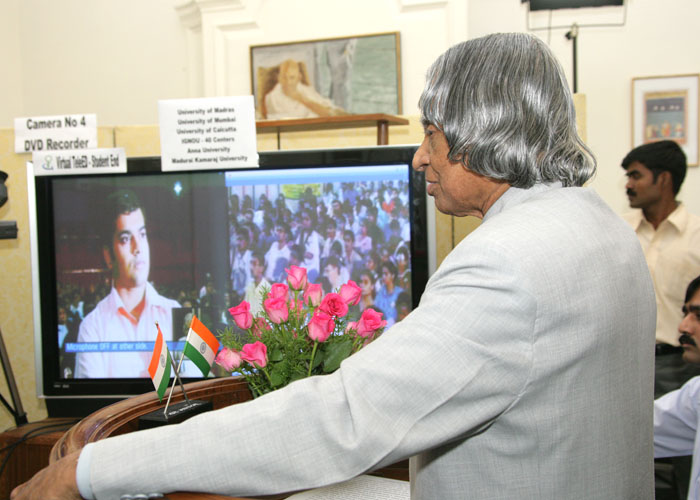

Questions from the students of Mumbai University
1. What is the future of women in Indian Politics when all the political parties are opposing the women?s bill?
- Varsha R. Patil, Kirti College
Ans. Definitely the reservation of 33% sought will come. It is only a matter of time. Success generally does not come without encountering problems. My Guru Prof Satish Dhawan used to tell ?if you do not work, no problem will occur, but if you do a mission or task definitely problems of varying magnitudes will crop up. But problems should not become the master of the individuals, individuals should become master of the problem, defeat and succeed?. This is what women have to do collectively for getting the bill passed.
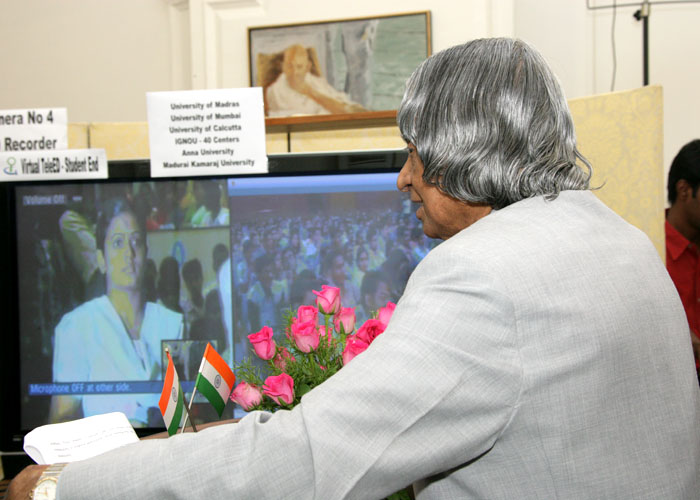
2. How can we make a village self-dependent? What is the role of remote village in the world power?
- Prafulla Sawant, Department of Marathi, Mumbai University
Ans. PURA is one route through which a village can be made self dependent. The villagers have got to be empowered with knowledge which can come through the establishment of village knowledge centre in each of the village or the Panchayat. Technology can play a major role in making the village self-sustaining. As small drops makes an ocean, collection of villages makes a district, a collection districts makes a State, collection of states makes a nation and collection of nation makes the world. There is a distinct relationship between the village and the world around us.
3. We are talking very high of solid waste management. At some residential societies and institutions we are converting the biodegradable waste into manure using various methods. Why do we not take this up on a war footing so that all the solid waste is converted into useful product and each city and village in our country wears a neat look?
- Nair Swapna Bhaskaran, NES Ratnam College of Arts, Science and Commerce, Mumbai.
Ans. Presently there are two power plants functioning in Andhra Pradesh which are being run using solid municipal waste. They generate 6.5 MWs of power each. This power is being fed into the grid. I am sure Municipal authorities can study this model and implement it in metropolitan cities like Calcutta, Chennai and Mumbai also.
4. Why are we not able to make Primary Education mandatory in our country?
- Rakesh R. Mishra, NES Ratnam College of Arts, Science & Commerce, Bhandup, Mumbai.
Ans.Assent has been accorded for the 86th Constitution Amendment Act ? Right to Education Bill for children between the age group of 5 and 14 years. But an Act alone cannot achieve the goal unless the education is delivered in a manner, which will take into account the socio-economic reality, and perception of people to whom it is addressed. Apart from attracting children to schools, the education system should be able to provide nourishment and inject creativity among the children. Also the aim of the education system should be to build character, human values, enhance the learning capacity through technology and build the confidence among children to face the future.
5. Mumbai was hit with unprecedented floods that destroyed property worth Rs. 5000 crores and many precious lives. This could have been minimized had the state government acted in time and with required sincerity. My question to you Sir is : What should we do as students to avoid recurrence of such a calamity?
- Avinash J Poojari, NES Ratnam College of Arts, Science and Commerce
In my many interactions with school children, parents, teachers and educationist, I have been told that our existing educational process tends to emphasize learning by memory rather than strengthening creativity. The essence of Science & Technology on the other hand is embedded in two of the most fundamental impulses ? the desire to discover and the desire to invent. It is vital that our education process nurtures and nourishes these two impulses.
An attempt in this direction has been made in a pilot programme called "Mapping the Neighbourhood" initiated by the Department of Science and Technology. In Almora district in Uttaranchal children from 20 schools have been motivated to use mapping techniques to investigate and map basic socio-economic, environmental and ecological issues being faced by the neighbourhood community. Armed with the scientific and technological tools such as Global Positioning System (GPS), Geographic Information System (GIS), Space Imagery incorporated in the hand held computers, the children are creating maps with the neighbourhood details to improve their understanding of the immediate environment. These maps will enable further the technological community to find solutions for the regeneration of fast disappearing natural sources of water, improving road connectivity, finding better locations for electricity and water distribution points, reducing traffic congestion and improved systems of garbage collection. Such a system may be adopted in Mumbai schools and colleges which will make learning a fun and also provide vital civic systems performance evaluation to the municipal authorities. Based on these maps they can take corrective action for preventing cumulative damage during the natural calamity. The students can carry out gradient survey of the Mithi river. Universities can also work on a programme of creating underground water storage systems in metropolitan cities.

Questions from the students of Madras University
1. How can tele-education enlighten, motivate and inspire high quality teaching among our young teachers?
- R. Jerina Jasmine and one other from II BCA, Annai Venlankanni College
Ans. Through tele-education, teachers will have an opportunity to listen to the teaching of the best teachers irrespective of the place from where they conduct classes. Also, they will be able to assess their own performance in relation to experts in the field. Thirdly the connectivity between peers will give an opportunity to learn more about the discipline in which they are working. All these take place effortlessly for the teacher. This will be the benefit of tele-education to inspire high quality teaching among our young teachers. Peer interaction itself will enlarge the vision of the teachers.
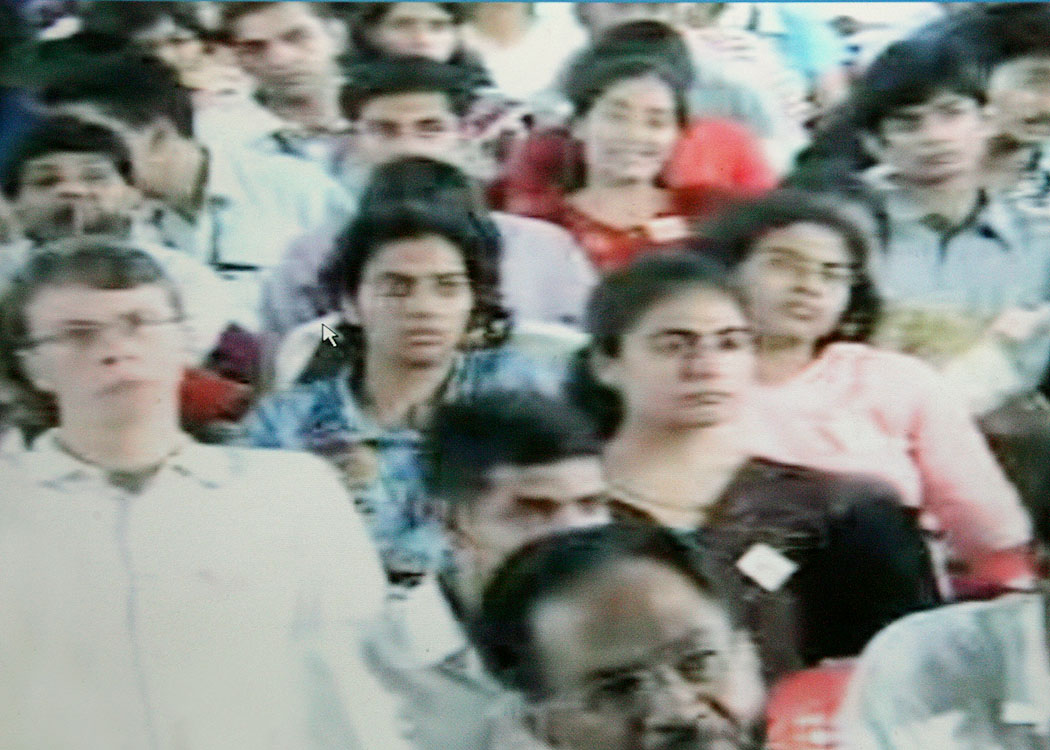
2. What kind of enhancement can tele-education make to benefit physically and visually challenged students?
- M. Vikas Munot and one other from Loyola College
Ans. Physically challenged children don?t need to move from their houses. They can have interactive tele-education package delivered at their home or very close where they can reach easily. For visually challenged children we can create applet which can convert reading material into audio material so that the lesson can be heard by the visually challenged child. This is the enhancement which tele-education can provide to the special children.
3. Let us assume that tele-education reaches all corners of India despite geographical, economic and technological barriers. Can it then eradicate the problems of illiteracy, dropouts and child labour?
- S. Jasmine Bernethu and twelve others from III B.Com, Mar Gregorios College
Ans. Yes it will. Azim Premji model exactly addresses the problem of motivating a child through computer aided learning. This is supported by the teachers, parents and village groups who constantly motivate the child to attend the school. If such models are replicated in different parts of the country definitely drop out will reduce and literacy will be promoted. For removing child labour we have to ensure that the parents get good employment. If the parents are able to earn a reasonable wage they will certainly not send their child to undertake jobs at an age when they are supposed to study. Each student must take a mission of teaching at least five students during their holidays in his or her region. This will definitely remove illiteracy from the country.
4. Given the high costs of tele-education and our economic situation, is tele-education for super individuals or common individuals?
- Nishana and seven others from III B.Sc., (Bio Chemistry), Asan Memorial College of Arts & Science.
Ans. If the tele-education is provided in a large scale using an innovative software it is not at all costly since the requirement of hardware considerably comes down. Presently, cost comparison is being made using a video conferencing system in mind. The overall costing of tele-education has also to be seen along with the saving in different costs such as movement of people to different places, saving in commuting time and ability to stay in a low budget village atmosphere instead of reaching a city for quality education. It will also remove the problem of shortage of teachers. A model exists in Kerala where a teacher is conducting classes for a child in California and teaches the child to do the home work after the school hours through a tele-education package. This has been found to be a cheaper option for the child compared to what it would take to get a local tuition in California. It also enhances the earning capacity of our teachers.
5. As an individual how do you think I can transform India into a developed country?
- B. Sailakshmi and one other from III B.Sc. Chemistry, Chellammal Women?s College
Ans. First of all I would like you to study well and excel in the subject of your choice. This will make you a competent person to undertake complex jobs after your education. While being in college you can use your holidays to educate at least five people who cannot read and write. You can also plant five trees in your school premises or neighbouring areas and nurture it till it becomes self-sustaining.
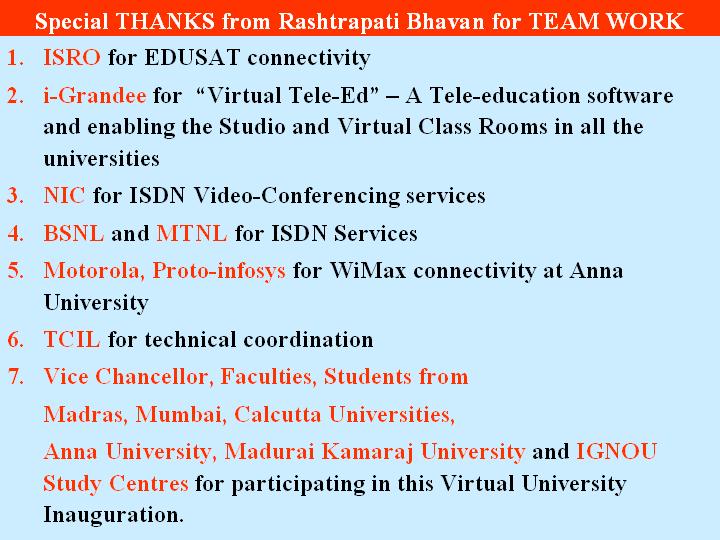
<<Back
|
|